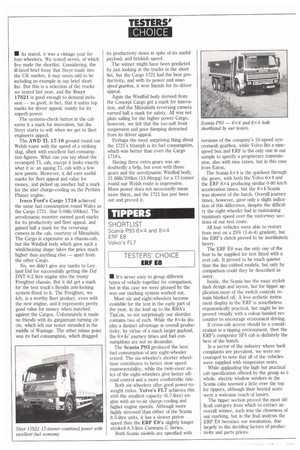Scania P93 6x4 and 8x4 ERF E8 Volvo's FL7
Page 44

If you've noticed an error in this article please click here to report it so we can fix it.
TESTERS' CHOICE ERF ER
11 It's never easy to group different types of vehicle together for comparison, but in this case we were pleased by the way our marking system worked out.
Most six and eight-wheelers become available for the test in the early part of the year, in the lead up to the RHA's TipCon, so not surprisingly our shortlist contains two of each. While the 8x4s display a distinct advantage in overall productivity, by virtue of a much larger payload, the 6x 4s' journey times and fuel consumptions are not so dissimilar.
The Scania P93 produced the best fuel consumption of any eight-wheeler tested. The six-wheeler's shorter wheelbase contributes to better slow speed manoeuvrability, while the twin-steer axles of the eight-wheelers give better offroad control and a more comfortable ride.
Both six-wheelers offer good power-toweight ratios. Volvo's FL7 achieves this with the smallest capacity (6.7-litre) engine with air-to-air charge-cooling and higher engine speeds. Although more highly stressed than either of the Scania 8.5-litre units, it has a slower piston speed than the ERF E8's slightly longer stroked 8.3-litre Cummins C Series.
Both Scania models are specified with versions of the company's 10-speed syncromesh gearbox, while Volvo fits a ninespeed box and ERF is the only one in our sample to specify a proprietary transmission, also with nine ratios, but in this case from Eaton.
The Scalia 6x4 is the quickest through the gears, with both the Volvo 6x4 and the ERF 8x4 producing similar 0-80 km/h acceleration times, but the 8x4 Scania was slowest of the batch. Overall journey times, however, gave only a slight indication of this difference, despite the difficulty the eight-wheeler had in maintaining maximum speed over the motorway sections of our test route.
All four vehicles were able to restart from rest on a 25% (1-in-4) gradient, but the ERF's clutch proved to be inordinately heavy.
The ERF E8 was the only one of the four to be supplied for test fitted with a rest cab. It proved to be much quieter than the day-cabbed models, but only by comparison could they be described as noisy.
Inside, the Scania has the most stylish dash design and layout, but for tipper application most of the switch controls remain blanked off. A less asthetic instrument display in the ERF is nonetheless ergonomically practical, but might be improved visually with a colour-banded rev counter to encourage economical driving.
If cross-cab access should be a consideration in a tipping environment, then the ERF's composite SP4 cab is definitely the best of the bunch.
In a sector of the industry where back complaints are prevalent, we were encouraged to note that all of the vehicles were supplied with suspension seats.
While applauding the high but practical cab specification offered by the group as a whole, electric window winders in the Scania cabs seemed a little over the top for tippers, although their heated seats were a welcome touch of luxury.
The tipper section proved the most difficult category from which to extract an overall winner, such was the closeness of our marking, but in the final analysis the ERP E8 becomes our nomination, due largely to the deciding factors of productivity and parts prices.
































































































































